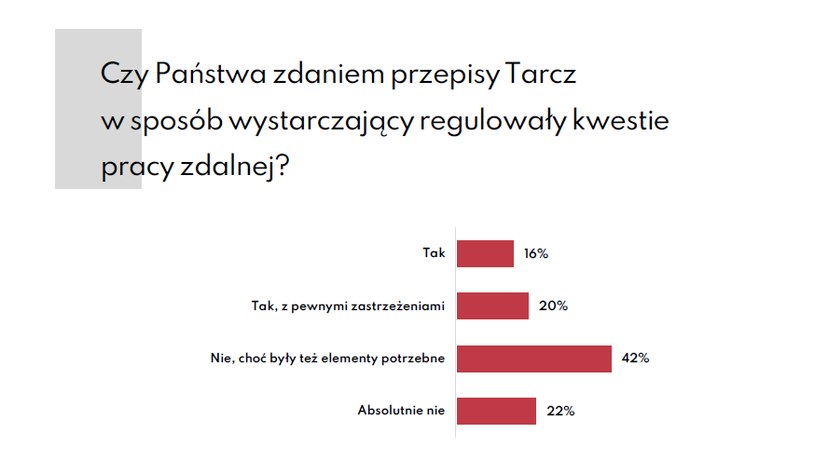
–
DGTL report Kibil Piecuch i Wspólnicy
/
The number of people who could use the lifts and dining rooms at the same time was also limited, cutlery and cups were replaced with water bottles, disposable cutlery, and even kitchens were turned off completely by moving coffee machines to open spaces. Finally, internal gyms were also shut down.
The majority of employers, because nearly 90 percent. decided to equip all home workers with computer equipment. For those who were forced to start working remotely in the first wave of isolation, and did not have a mobile computer, the employer made it possible to take desktop computers home, or they were brought to them by employers (e.g. by taxis). Nearly three-fourths of employers equipped their employees with appropriate software, including VPN, enabling them to safely connect to the employer’s infrastructure. Although access to the network is not difficult – 30 percent. of companies provided employees with additional network access and, in part, additional routers.
What was managed quite efficiently in terms of logistics and hardware, was not so easy from the legal point of view, because at the time of the outbreak of the pandemic, there were no legal regulations regarding the principles of remote work. The formal possibility of outsourcing remote work was introduced in the Act of March 2, 2020, but any clarification of the basic rules was introduced only by the Act of June 19, 2020.
The survey and the companies’ responses clearly show that this is one of the greatest difficulties for employers.
Although the provisions on remote work were crucial for employers, they are assessed as insufficiently regulating these issues (this is how over 60% of respondents assessed them).
Therefore, it can be seen that there is a need for regulating remote work on the part of employers. The scope of the introduced changes was not sufficient in the context of numerous questions that arose on the part of employers (including in the field of occupational health and safety of remote workers, covering costs incurred by the employee, medical examinations or working time) – emphasize the authors of the report.
At the same time, over 3/4 of employers decided to introduce regulations concerning the performance of remote work by employees. More than 1/3 did it using separate internal documents, and 30% through changes in regulations already in force for employees. Only 12 percent. employers introduced changes to the conditions of work in the Work Regulations. In other cases, these were, for example, instructions for safe remote work, sets of good practices, sets of questions and answers for remote work. In most cases, regulations on remote work were avoided due to concerns about negotiating changes with trade unions or the need to provide regulations with adequate flexibility, adapted to the rapidly changing reality.
Expert opinion:
prof. Monika Gładoch, head of the Department of Labor Law at the Cardinal Stefan Wyszyński University, author of the study Praca Zdalna w Practice. Legal issues.
I am not surprised by the opinion of the respondents regarding the insufficient regulation of remote work. Let me remind you that for the first three months, the provisions were limited to defining remote work and granting the employer the right to order it unilaterally. It is worth remembering that for remote work, which is an institution reserved in principle for employment on the basis of an employment contract, we apply all labor law provisions, including concerning working time, occupational health and safety, inspections, etc. The most frequently reported postulate in terms of changing the remote work regulations was granting employees the right to demand an equivalent for using their own equipment. On the other hand, employers expect clarification of the provisions on health and safety and working time. I think that an important solution would be, for example, to allow the average weekly norm. The daily standard often becomes a fiction because, depending on the number of tasks, an employee works longer one day and shorter another day. Unfortunately, the proposal submitted by the former Ministry of Family, Labor and Social Policy does not take into account these needs and consists largely in rewriting the regulation on teleworking and replacing it with remote work. So I am afraid that there may be an overregulation of remote work again, as currently teleworking. Let me put it straight, the regulation of remote work that is currently in force is definitely better than the proposal resulting from the governmental draft, which was submitted to the Social Dialogue Council.
Monika Krześniak-Sajewicz
–


